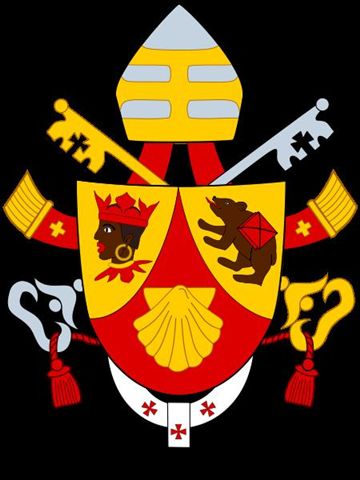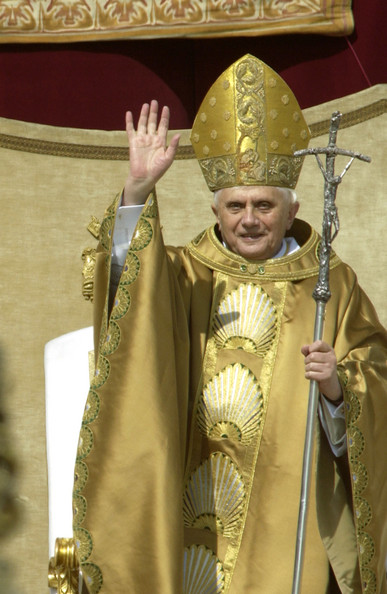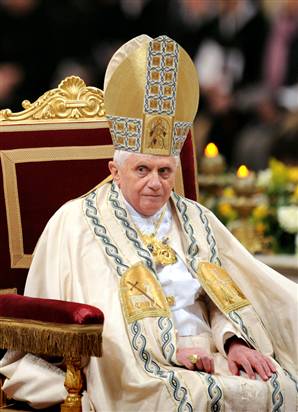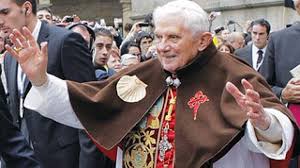Much of the information presented here on Roman Catholicism was taken from A Practical Catholic Dictionary, by Jessie Corrigan Pegis, 1957. It has the imprimatur of Francis Cardinal Spellman, at that time the Archbishop of New York. Its views are therefore considered the views of the Roman Catholic Church.
What is a Roman Catholic?
A Practical Catholic Dictionary defines a Roman Catholic as “a member of the Roman Catholic Church, which has its center in Rome” (p. 188).
What is the Roman Catholic Church?
A Practical Catholic Dictionary has no entry for “Roman Catholic Church,” but it defines Catholic Church as:
“The one true Church established by Jesus Christ. It is called the Catholic Church from the word catholic which means universal or concerning all. See Catholic. Jesus Christ intended the Catholic Church to be for all men and for all time. Just before His Ascension, He said to His Apostles, ‘All power in heaven and on earth has been given to me. Go, therefore, and make disciples of all nations, baptizing them in the name of the Father, and of the Son, and of the Holy Spirit, teaching them to observe all that I have commanded you; and behold, I am with you all days, even unto the consummation of the world.’ Matthew XXVIII 18-20.”
A Practical Catholic Dictionary, p. 50
The Roman Catholic Church is much more than a church. It has its own language (Latin), its own religion (Roman Catholicism), its own government (the Holy See), its own laws (Canon Law), its own army, and its own currency (Vatican Lira or Papal Lira). It is headquartered in Vatican City, a recognized city-state; which, at one square mile, is the smallest country in the world.
It is called “Roman” Catholic for a reason
It is curious that A Practical Catholic Dictionary defines a Roman Catholic as a member of the Roman Catholic Church, yet contains no entry for “Roman Catholic Church.” If being Roman were not integral to a Roman Catholic’s identity, then a member of the Roman Catholic Church would not be called a Roman Catholic, but merely a Catholic. In fact, if being Roman were not integral to the Roman Catholic Church’s identity, then there would be no reference to the Roman Catholic Church at all: there would only be “Catholic Church.”
Roman Catholic Church not founded by Jesus Christ
The Vatican claims that the Lord Jesus Christ founded the Roman Catholic Church. This cannot be, however, because the Lord Jesus was in Jerusalem, not Rome, when He made the statement recorded in Mathew 28: 18-20. Moreover, if the Lord Jesus had called His church catholic, intending for it to be “for all men and for all time,” He wouldn’t have called it Roman, which means:
1. “of or pertaining to the ancient or modern city of Rome, or to its inhabitants or their customs and culture;
2. of or pertaining to the ancient kingdom, republic, and empire of Rome;
3. of a kind or character regarded as typical of the ancient Romans” (Random House Collegiate Dictionary).
Jesus Christ was a Jew (as were His Apostles and the first disciples), and his religion was based on the belief that He was the Son of Jehovah, the God of the Jews. It would therefore make no sense for the Lord to identify His church with Rome, as the Romans were not monotheistic, but pantheistic, worshipping a plethora of gods, including Mars and Diana.
Roman Catholic Church founded by a Roman
The Roman Catholic Church was founded in 313 A.D. by the Roman Emperor, Constantine The Great. The Romans traditionally practiced the Mystery Religion of ancient Babylon, worshipping the Roman pantheon of gods, including the goddess Diana. Constantine himself worshipped the sun god, Sol Invictus. Bible-based Christianity, first preached in Rome by the Apostle Paul (Acts 28:16:31), was fast making inroads in the empire, and growing exponentially, despite severe persecution. With Romans leaving paganism in droves and becoming Christians, Constantine’s power was threatened. He therefore devised a means to both placate the pagans, who were his power base, and conciliate the growing Christian population. Combining Christianity with paganism, Constantine created a new religion under which he would consolidate the empire. To that end, he issued the Edict of Milan, ordering persecutions against the Christians to cease, and making his new religion, which he called Roman Catholicism, the universal religion of the empire (catholic means universal). Constantine made himself the head of the religion, taking the title, Pontifex Maximus; and the Roman Catholic Church was born.
When Constantine moved his headquarters from Rome to Byzantium (modern-day Istanbul, Turkey), the Empire’s capital in the east, the priests of Rome took charge of the temporal affairs of the Western Empire. Taking the title papa or Pope (Latin for father), the head priest declared himself the ultimate temporal and spiritual authority. The popes’ authority was at first largely ignored, until the French king Charlemagne took an army to Italy and established the power of the Papacy. Grateful, the Pope crowned Charlemagne the first Holy Roman Emperor in 800 A.D.; and the Roman Empire, a political entity, became the Holy Roman Empire, a theocracy.
Disciples of Jesus never called their religion Roman Catholicism
According to the Book of the Acts of the Apostles, which records the creation of the first-century Church, the disciples of Jesus called their religion The Way:
“And Saul, yet breathing out threatenings and slaughter against the disciples of the Lord, went unto the high priest, and desired of him letters to Damascus to the synagogues that if he found any of this way…he might bring them bound unto Jerusalem.”
Acts 9:1,2
“And a certain Jew named Apollos, born at Alexandria, an eloquent man, and mighty in the Scriptures, came to Ephesus. This man was instructed in the way of the Lord; and being fervent in the spirit, he spake and taught diligently the things of the Lord, knowing only the baptism of John. And he began to speak boldly in the synagogue: which, when Aquila and Priscilla had heard, they took him unto them, and expounded unto him the way of God more perfectly.”
Acts 18:24-26
“And [Paul] went into the synagogue, and spake boldly for the space of three months, disputing and persuading the things concerning the kingdom of God. But when divers were hardened, and believed not, but spake evil of that way before the multitude, he departed from them….“
Acts 19:8,9
“So he [Paul] sent into Macedonia two of them that ministered unto him, Timotheus and Erastus; but he himself stayed in Asia for a season. And about the same time there arose no small stir about that way.“
Acts 19:22-23
Testifying in Caesaria of his former persecution of the followers of Jesus, Paul said:
“And I persecuted this way unto the death, binding and delivering into prisons both men and women.”
Acts 22:4
Testifying before the Roman governor Felix of his own belief in the Lord Jesus, Paul said:
“But this I confess unto thee, that after the way which they call heresy, so worship I the God of my fathers….”
Acts 24:14
“And when Felix heard these things, having more perfect knowledge of that way, he said…I will know the uttermost of your matter.”
Acts 24:22
The disciples called their religion The Way, because the Lord Jesus said He was The Way:
“I am the Way, the Truth, and the Life; no man cometh unto the Father but by me”
John 14:6
Disciples of Jesus were never called Roman Catholics
Never were the disciples of Jesus called Roman Catholics. They were called Christians…
“And the disciples were called Christians first in Antioch.”
Acts 11:26
“Then Agrippa said unto Paul, Almost thou persuadest me to be a Christian.”
Acts 26:28
“Yet if any man suffer as a Christian, let him not be ashamed; but let him glorify God on this behalf.”
1 Peter 4:16
…and they were called Nazarenes:
“For we have found this man [Paul] a pestilent fellow, and a mover of sedition among all the Jews throughout the world, and a ringleader of the sect of the Nazarenes…”
Acts 24:5
But they were never called Roman Catholics.
Roman Catholicism is Mystery Babylon
Roman Catholicism is not the worship of Jesus Christ, but is actually the worship of Cush, Nimrod and Semiramis—history’s first deified mortals and the original satanic trinity. The Bible calls it Mystery Babylon:
Cush
According to the Bible, Cush was the grandson of the patriarch Noah, one of eight people to survive the Great Flood. Known as Al Khem, “The Burnt One,” and Ethiops “The Black One,” Cush is the father of the dark-skinned races. It is from Al Khem that we get the occult term alchemical. This is important, as alchemy is merely another name for the Mystery Religon, which Cush founded. Cush was also known as Hermes Trismegistos or “thrice-greatest Hermes.” Hermes means “son of Her (Ham).”
Nimrod
Cush’s son Nimrod was the first king of Babylon, the first kingdom mentioned in the Bible. He was also the first deified mortal in history. The Bible says this about Nimrod:
“And Cush begat Nimrod; he began to be a mighty one in the earth, he was a mighty hunter before the Lord” (Genesis 9:20).
This is proof that Nimrod was worhsipped, as the word translated “mighty one” is the Hebrew word el, which means a god.
Semiramis
Nimrod’s wife Semiramis was Babylon’s first queen. She was formerly the wife of Nimrod’s father Cush; and, like Nimrod, she was also deified. Historian Alexander Hislop writes in The Two Babylons that Semiramis was known in the old world as Myrianimus, “The Goddess of Ten Thousand Names.”
Evidence that the Roman Catholic Church worships Cush, Nimrod and Semiramis can be found on the coat of arms of Pope Emeritus Benedict XVI.

The coat of arms features a black king, a bear with its tongue sticking out, and a seashell. None of these symbols are used in the Bible as symbols for the Lord Jesus Christ, but they do have great significance in the Mystery Religion. The black king may be Cush, and the bear, Nimrod. Nimrod was also known as Tammuz, which would account for the “T” on the bear’s side. On the other hand, both the king and the bear could be Nimrod; as two occult symbols are often presented together to associate the one with the other. Nothing is coincidental or arbitrary in the world of the occult, so the fact that both the king and the bear are black is significant.
The seashell is at the center, signifying that it is more important than the other two symbols. The Bible does not use the seashell as a symbol for Jesus Christ, so it must represent something or someone else. The seashell is in fact a symbol for Semiramis, who, in Rome, was worshipped as Venus and Diana. According to Roman mythology, Venus was born of the sea, and emerged fully grown from a seashell.

The Roman Catholic Church worships Venus as the Virgin Mary, and uses the seashell as one of her symbols. The title Mary comes from the Latin word mari, which means sea. This is the origin of the Virgin Mary’s title “Star of the Sea.” The seashell is a prominent symbol in the Roman Catholic Church.



Pope Francis even admitted (in twilight language) that the Roman Catholic Church is Mystery Babylon:
Pope Francis’ reference to a “widowed church in search of her spouse” is a veiled allusion to Semiramis searching for her slain husband Nimrod. Legend has it that Shem, the middle son of Noah and father of the Semitic peoples, including the Jews, killed Nimrod for his abominable practices. Shem then cut Nimrod’s body into fourteen pieces and sent them throughout the known world as a warning to anyone who dared continue in the religion of Nimrod. Semiramis scoured the world searching for those pieces, and managed to secure all but one—his phallus. Semiramis then fashioned a new phallus out of gold and reassembled her husband.
This story is illustrated in allegorical form in the Egyptian legend of Isis and Osiris. Watch this video and note the similarities: